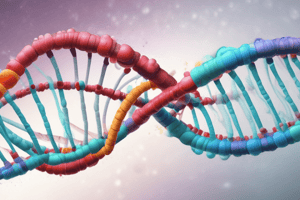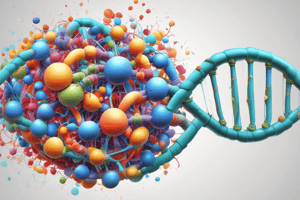Podcast
Questions and Answers
What is the sugar molecule found in DNA nucleotides?
What is the sugar molecule found in DNA nucleotides?
- Deoxyribose (correct)
- Fructose
- Glucose
- Ribose
Which of the following is NOT a step in DNA replication?
Which of the following is NOT a step in DNA replication?
- DNA polymerase synthesizes new strands
- Helicase unwinds the double helix
- Transcription of DNA into RNA (correct)
- Ligase seals the gaps between nucleotides
What is the result of a point mutation in a DNA sequence?
What is the result of a point mutation in a DNA sequence?
- A change in the structure of a protein
- An insertion or deletion of nucleotides
- A change in the number of chromosomes
- A substitution of one nucleotide for another (correct)
What is the law of segregation in Mendel's laws?
What is the law of segregation in Mendel's laws?
What is the process of converting DNA into RNA?
What is the process of converting DNA into RNA?
Which of the following is an example of a chromosomal mutation?
Which of the following is an example of a chromosomal mutation?
What is the result of gene expression?
What is the result of gene expression?
Which of the following is an example of autosomal dominant inheritance?
Which of the following is an example of autosomal dominant inheritance?
Flashcards
DNA Structure
DNA Structure
DNA is a double-stranded helix made of nucleotides.
Nucleotide Components
Nucleotide Components
Nucleotides consist of sugar, phosphate group, and nitrogenous base.
Adenine-Thymine Pairing
Adenine-Thymine Pairing
Adenine (A) pairs with Thymine (T) in DNA structure.
RNA Function
RNA Function
Signup and view all the flashcards
Semi-Conservative Replication
Semi-Conservative Replication
Signup and view all the flashcards
Transcription Process
Transcription Process
Signup and view all the flashcards
Point Mutations
Point Mutations
Signup and view all the flashcards
Mendel's Law of Segregation
Mendel's Law of Segregation
Signup and view all the flashcards
Study Notes
DNA Structure and Replication
- DNA (Deoxyribonucleic acid) is a double-stranded helix composed of nucleotides
- Each nucleotide consists of:
- Sugar molecule (deoxyribose)
- Phosphate group
- Nitrogenous base (A, C, G, or T)
- Hydrogen bonds between nitrogenous bases hold the two strands together
- Adenine (A) pairs with Thymine (T) and Guanine (G) pairs with Cytosine (C)
Central Dogma
- DNA is transcribed into RNA (ribonucleic acid)
- RNA is translated into proteins
- Proteins perform various cellular functions
- Genetic information flows from DNA to RNA to proteins
DNA Replication
- Semi-conservative replication: each new DNA molecule consists of one old strand and one new strand
- Steps:
- Helicase unwinds the double helix
- Primase adds RNA primers to the template strands
- DNA polymerase synthesizes new strands
- Ligase seals the gaps between nucleotides
Gene Expression
- Gene expression is the process by which genetic information is converted into a functional product
- Steps:
- Transcription: DNA is transcribed into RNA
- Translation: RNA is translated into a protein
- Post-translational modification: protein is modified to become functional
Mutations
- A change in the DNA sequence
- Types:
- Point mutations: substitution of one nucleotide for another
- Frameshift mutations: insertion or deletion of nucleotides
- Chromosomal mutations: changes in the number or structure of chromosomes
Inheritance Patterns
- Mendel's laws:
- The law of segregation: each pair of alleles separates during gamete formation
- The law of independent assortment: alleles for different genes are sorted independently
- The law of dominance: one allele can be dominant over another
- Autosomal dominant/recessive inheritance
- X-linked inheritance
- Polygenic inheritance
DNA Structure
- DNA is a double-stranded helix composed of nucleotides, each consisting of a sugar molecule (deoxyribose), a phosphate group, and a nitrogenous base (A, C, G, or T)
- Hydrogen bonds between nitrogenous bases hold the two strands together
- Adenine (A) pairs with Thymine (T) and Guanine (G) pairs with Cytosine (C)
Central Dogma
- DNA is transcribed into RNA (ribonucleic acid)
- RNA is translated into proteins
- Proteins perform various cellular functions
- Genetic information flows from DNA to RNA to proteins
DNA Replication
- Semi-conservative replication: each new DNA molecule consists of one old strand and one new strand
- Helicase unwinds the double helix
- Primase adds RNA primers to the template strands
- DNA polymerase synthesizes new strands
- Ligase seals the gaps between nucleotides
Gene Expression
- Gene expression is the process by which genetic information is converted into a functional product
- Transcription: DNA is transcribed into RNA
- Translation: RNA is translated into a protein
- Post-translational modification: protein is modified to become functional
Mutations
- A change in the DNA sequence
- Point mutations: substitution of one nucleotide for another
- Frameshift mutations: insertion or deletion of nucleotides
- Chromosomal mutations: changes in the number or structure of chromosomes
Inheritance Patterns
- Mendel's laws:
- The law of segregation: each pair of alleles separates during gamete formation
- The law of independent assortment: alleles for different genes are sorted independently
- The law of dominance: one allele can be dominant over another
- Autosomal dominant/recessive inheritance
- X-linked inheritance
- Polygenic inheritance
Studying That Suits You
Use AI to generate personalized quizzes and flashcards to suit your learning preferences.
Description
This quiz covers the structure and replication of DNA, including its double-stranded helix composition and the process of transcription and translation.




